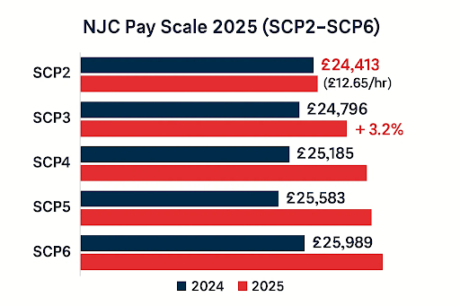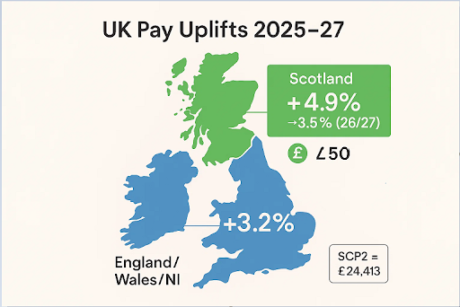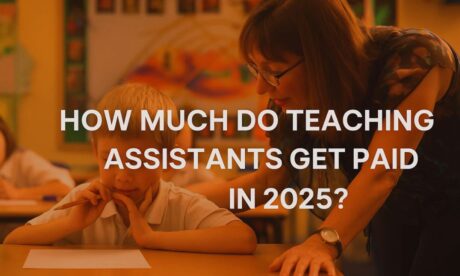
How much do teaching assistants earn in the UK? Teaching assistants are the backbone of classrooms, supporting teachers and helping children thrive every day. But what does that look like on a payslip?
From 1 April 2025, most TAs on council (NJC) contracts will start on £24,413 FTE, thanks to a 3.2% pay rise. This uplift means thousands of assistants will see a welcome boost in their pay packets. In Scotland, pay works a little differently. Staff there follow a separate national agreement, and under the 2025/26 deal, salaries will rise by 4%.
So, if you’ve ever wondered “how much do teaching assistants earn in the UK”, the answer depends on where you work — but the good news is that pay is on the rise across the board.
How Much Do Teaching Assistants Earn?
Most schools in England, Wales, and Northern Ireland follow the NJC “Green Book” pay system. This means your salary links directly to council pay scales. You are on the same structure as other council support staff.
Full-Time Equivalent (FTE) vs Real Pay
Job adverts normally show a full-time equivalent (FTE) figure. For example, SCP2 will be £24,413 FTE from April 2025. But most teaching assistants don’t work 37 hours a week, 52 weeks a year. Instead, your school pro-rates your pay to match your contracted hours and term-time weeks.
Here’s how it works:
- The school adds your worked weeks plus holiday allowance.
- That total is your paid weeks per year.
- Your FTE is then reduced to reflect those weeks and hours.
- Finally, your council spreads the result evenly across 12 monthly payslips.
This is why your advertised FTE always looks higher than your actual monthly pay.

Example
- FTE (SCP2): £24,413.
- Contract: 32.5 hours per week, 39 weeks per year.
- Paid weeks after holiday: about 44.6 weeks.
- Actual pay: around £18,000 per year.
- Monthly wage: about £1,500 gross.
So even though the job ad says £24,413, you actually take home the pro-rated version spread across the year.
Pay Rise in 2025
From 1 April 2025, NJC salaries rise by +3.2%. This deal comes through the Local Government Association. Unions like ASCL confirm the increases for staff. Councils then update their own tables, so always check your HR pages for the exact scale used in your area.
New Rates 2025
From 1 April 2025, pay for teaching assistants on council contracts (NJC scales) will look like this:
- SCP2 (Starter): £24,413 a year → about £12.65 an hour
- SCP3: £24,796 a year
- SCP4: £25,185 a year
- SCP5: £25,583 a year
- SCP6: £25,989 a year
What “SCP” Means
SCP stands for Spinal Column Point. Think of it as a step on the official council pay ladder. SCP2 is where most new teaching assistants start. Each time you move up (to SCP3, SCP4, etc.), your salary increases slightly. The rises aren’t huge, but over time they add up.
Why It Matters
- Fairness: All councils using NJC scales follow the same structure, so pay is transparent.
- Progression: Moving up SCPs usually depends on experience, responsibilities, or length of service.
- Annual Updates: Every April, the pay tables are revised, often with a small percentage increase. For April 2025, that’s a 3.2% uplift.
Where to Check
Councils publish the full tables every April. Examples:
- Teach in Herts pay scales (Hertfordshire)
- Blaenau Gwent CBC pay tables (Wales)
Term-Time Only Pay
Teaching assistants often ask about their real take-home pay. Here’s the simple version.
You’re paid for your worked weeks plus holiday weeks. Then your pay spreads evenly across 12 months. Councils usually use a 52.143-week divisor when working out hourly rates. This keeps things fair. But remember: never compare your pro-rated pay to the full-time equivalent (FTE) headline figure. They are not the same. Check local examples at the Local Government Association
FTE vs Pro-Rated (Quick Explainer)
- FTE example: SCP2 = £24,413 (all year, full-time).
- Pro-rated example: 32.5 hours a week, term-time only = around £18,000.
- The school still pays you in 12 equal monthly instalments.
Where You Work Matters (London & Local Add-Ons)
Pay depends on where you work. Some areas add London or Fringe weighting. Others give local allowances on top. These extras also rise with the +3.2% 2025 award. But the amounts differ by council. Always check your HR pages for the exact figure.
Scotland vs Rest of UK (Know the Split)
Teaching assistant pay isn’t the same everywhere. Here’s the split.
- England, Wales, and Northern Ireland: NJC deal with +3.2% from 1 April 2025. Starter pay (SCP2) = £24,413 FTE.
- Scotland: COSLA agreement with +4% in 2025/26, then +3.5% in 2026/27. This covers council support staff, including TAs.

Benefits & Perks That Add Real Value
Pay is only part of the picture. Teaching assistants also get valuable extras.
- Local Government Pension (LGPS): A strong, secure scheme with generous employer contributions, giving staff long-term financial security in retirement.
- Annual Leave: A generous holiday allowance, adjusted (pro-rated) for term-time contracts. Even for term-time staff, salaries are spread across the year to ensure regular monthly pay.
- Job Security: Council and school contracts offer reliable, permanent positions that are less vulnerable to sudden cuts compared to many private-sector roles.
- Wellbeing Support: Employee Assistance Programmes, confidential helplines, occupational health services, and wellbeing initiatives. Some councils also offer staff discount schemes for: shopping, leisure, and travel.
- Training and CPD: Funded training courses, workshops, and qualifications. Many local authorities actively support staff who want to progress into higher level TA roles, SEN specialisms, or even teacher training.
- Work–Life Balance: Term-time working patterns align with school holidays, which is especially valued by parents and those seeking predictable schedules.
- Career Progression Opportunities: Options to move into senior TA posts, pastoral or SEN support roles, or higher-level learning support positions.
- Union Representation: Many TAs benefit from strong union support, ensuring fair treatment and collective bargaining on pay and conditions.
- Community Impact: The role provides the chance to make a meaningful difference in children’s lives, offering a strong sense of purpose alongside financial rewards.
Tip: list your local perks in job ads or school pages. It makes your role stand out.
Recent Updates You Should Include
Keep an eye on pay updates. Here are the key points.
- NJC 2025/26: +3.2% to all points and allowances from 1 April 2025.
- SCP2: will be deleted on 1 April 2026. HR will share details about re-pointing before then.
- Scotland: staff backed the COSLA deal. This gives +4% in 2025/26, then +3.5% in 2026/27.
Check updates from: ASCL | Local Government Association | COSLA | Community Care
What Actually Moves TA Pay Up
Curious about teaching assistant pay and how to make it grow? Your starting salary is just the beginning — there are clear steps you can take to earn more over time.
1. Increase Your Hours or Weeks
Most TAs work term-time only, often 32.5 hours a week. If you add hours or take on extra weeks, your monthly pay rises. Even a small change, like covering lunchtime duty or after-school clubs, can make a difference.
2. Progress Spine Points with Experience
NJC pay uses “spine points.” You normally start on the lower points. Each year of service, your point can rise until you reach the top of your grade. This gives you steady, predictable pay growth without changing jobs.
3. Step Up to HLTA Level
If you want a bigger jump, aim for Higher Level Teaching Assistant (HLTA) roles. These jobs come with higher spine points and more responsibility. You may lead small group teaching, cover classes, or support planning. HLTA status often unlocks pay that’s closer to the £28,000+ range, depending on your council.
4. Location Allowances Add Extra
Where you work matters. Inner London, Outer London, and Fringe areas pay more. Councils add “weighting” on top of NJC scales to reflect higher living costs. This can add several thousand pounds a year to your salary.
5. Role-Based Add-Ons
Some councils also pay extra for special duties. Examples include SEN support, first-aid responsibility, or being a designated safeguarding lead assistant. These allowances vary, but they reward added skills and commitment.
HLTA -Higher Level Teaching Assistant (Why It Matters for Pay)
If you want to know how much do teaching assistants earn, it helps to see how HLTA roles change the picture.
Pay Position on the NJC Scale
Higher Level Teaching Assistants (HLTAs) usually sit several spine points above entry-level TA posts. While a starter TA might be on SCP2 (£24,413 FTE from April 2025), HLTA adverts often start several points higher. Depending on the council, HLTAs may sit anywhere from SCP7 to SCP12 or beyond. This step makes a clear difference in pay.
Duties and Responsibilities
HLTAs don’t just support in the classroom. They often:
- Lead small group interventions.
- Cover whole classes during teacher absence.
- Support lesson planning and delivery.
- Mentor other TAs.
- Because the duties are broader, the pay grade rises to match.
Real Difference in Pay
Moving from a standard TA to HLTA can add several thousand pounds a year. For example:
- TA (SCP2, FTE): £24,413.
- HLTA (SCP9, FTE): £26,873.
- HLTA (SCP12, FTE): £27,803.
Actual take-home will depend on your hours and weeks worked. But even pro-rated, the uplift is clear.
Why It Matters
For many TAs, the HLTA step is the best way to boost income without leaving support staff grades. It also opens doors to further training and potential teacher training routes later on.
Challenges to Be Honest About
When people ask how much do teaching assistants earn, it’s important to share the full picture. Pay can feel confusing, and there are real challenges to be aware of.
1. Term-Time Pro-Rating
The biggest confusion comes from FTE vs pro-rated pay. Job adverts use FTE figures, but TAs usually work term-time only. This means actual pay is lower once hours and weeks are adjusted. Always compare FTE with FTE to make sense of pay scales across roles or councils.
2. Variation by Employer
Most schools use the NJC system, but not all. Academies and sixth-form colleges can set their own scales. Many still mirror NJC, but some apply different starting points or allowances. This means two TAs in neighbouring schools may earn slightly different amounts.
3. Entry-Point Squeeze
Starting pay has improved with the 2025 uplift, yet early spine points can still feel tight compared to living costs. For new TAs, this can be discouraging. That’s why it helps to highlight the benefits package, such as the Local Government Pension, and the progression routes, such as moving up spine points or stepping into HLTA roles.
Is a Teaching Assistant a Good Job?
Many people ask: how much do teaching assistants earn and is the role worth it? The answer depends on what you value most in work.
Teaching assistants (TAs) play a vital part in schools. They support pupils, help teachers, and often bring energy into classrooms. Pay is not the highest in education, but recent rises have improved things. From April 2025, most TAs on NJC contracts start on £24,413 full-time equivalent (FTE). Scotland runs a different deal, with a 4% uplift in 2025/26.
How Much Do Teaching Assistants Earn and What Else Matters?
Actual take-home pay depends on hours and weeks worked. Many TAs work term-time only, so their pay is pro-rated. A 32.5 hour, 39 week contract usually gives around £18,000, spread over 12 months.
Pay does grow with experience. Moving up NJC spine points or stepping into a Higher Level Teaching Assistant (HLTA) role boosts salary. London or Fringe allowances also add more in some areas.
However, money is not the only factor. TAs also gain strong pensions through the Local Government Pension Scheme (LGPS). Councils provide paid leave, wellbeing support, and funded training. Many staff value the family-friendly hours and the chance to make a real impact.
So, is it a good job? If you seek high pay, it may feel limited. But if you want steady work, school hours, and the chance to help children every day, being a teaching assistant offers real rewards.
Mini FAQs
1. How much do teaching assistants get paid in the UK?
Most TAs earn between £24,413 and £25,989 (SCP2–SCP6) from April 2025, with slightly different rates in Scotland.
2. How much do TAs get paid per hour?
Around £12.65 an hour at the starter rate (SCP2), rising slightly with each step.
3. Do teaching assistants get paid during school holidays?
Yes — pay is annualised and spread evenly, so term-time staff still receive monthly pay during holidays.
4. Do level 3 teaching assistants get paid more?
Yes — higher-level TAs (Level 3) usually start on higher SCP points, earning more than entry-level roles.
5. What is the highest paying TA job?
Higher Level Teaching Assistants (HLTAs) or specialist SEN TAs are typically the best paid, often near the top of SCP6 or above in some councils.
6. How much does a level 4 TA earn?
A Level 4 TA can earn around £25,000–£26,000 (top of SCP6 or higher depending on the council pay structure).
Final Thoughts
So, how much do teaching assistants earn? From April 2025, most start on £24,413 FTE under the NJC deal, while Scotland offers a 4% rise. Actual take-home is lower for term-time contracts, often around £18,000 a year.
Pay grows with spine points, London weighting, or by moving into HLTA roles. Add in the pension, holidays, training, and wellbeing support, and the overall package is stronger than the headline salary suggests.
Teaching assistants may not earn the most in education, but the job brings steady pay, good benefits, and the chance to make a real difference every day.#
Enrol today in the Teaching Assistant Course at Unified Course and get the knowledge and confidence you need to succeed in schools.






